A Pinched Nerve in the Shoulder
Introduction:
A pinched nerve in the shoulder happens when nearby structures imping or irritates a nerve coming from the neck. When this happens in the shoulder blade, you experience numbness and pain spanning from the shoulder and down the arm and hand. This resulting shoulder pain and numbness of the arm and hand.
Doctors may also refer to a pinched nerve in the shoulder appearing from the neck as cervical radiculopathy.
An injury or changes to the body over time can cause a pinched nerve in the shoulder. Most cases of a pinched nerve in the shoulder go away with nonsurgical treatment.
What is a pinched nerve in the shoulder?
A pinched nerve in the shoulder (also known as “radiculopathy”) is a condition that results in neurological dysfunction caused by compression and inflammation of any of the nerve roots of your cervical spine (neck region). Neurological dysfunction can include radiating pain, muscle weakness, and tingling or numbness.
What is the cervical spine?
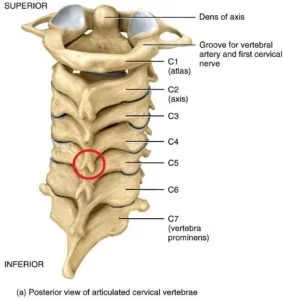
The cervical spine is an important one anatomically, clinically, and therapeutically. It is the region where the nerves of shoulders, arms, and hands arise through the brachial plexus and where the cervical plexus forms providing innervation to the diaphragm surrounded by other structures. It also allows the opening of important vascular structures to reach the brain and allows attachment area for muscles that move the head, neck, and shoulder girdle.
To understand this complicated region, we will consider the bony structures first, and then discuss the ligaments, nerves, and musculature that are associated with this region of the cervical spinal column, come to the conclusion with some clinical implications of damage to some of these structures. The cervical spine includes 7 vertebrae, C1 to C7, the cervical nerves from C1 to C8, muscles, and ligaments. The first two vertebrae C1 and C2 have unique shapes and functions. They form the upper cervical spine.
Nerves
Many important nerves arise from the cervical spinal cord.
Most of these nerves originate in one of two plexuses: The cervical plexus or The brachial plexus
C1 (Atlas) vertebrae support the skull. It articulates superiorly with the occiput which is known as the atlanto-occipital joint.
The atlanto-occipital joint is responsible for 33% of flexion and extension. The structure of the atlas allows forward and backward movement of the head.
Below the C1 (atlas) is the C2 (axis) that allows rotation. This joint (The atlantoaxial joint) is responsible for 60% of all cervical rotation. C3-C7 cervical vertebrae that make up the lower cervical spine, are similar to each other but very different from C1 and C2.
When a nerve root gets pinched, it can affect the nerves that are attached to it. This is why a pinched nerve in your shoulder can cause pain that radiates down your arm and hand.
What does a pinched nerve in the shoulder affect?
A pinched nerve in the shoulder caused by a herniated disc is more common in people up to 50 years old. And disc degeneration is more common in people between the ages the 50s-60s. People in their 70s or older tend to get a pinched nerve in the shoulder from foraminal narrowing as a result of arthritis in the cervical spine. The foramen is the bony hollow opening between vertebrae through which the spinal cord travel.
Pathophysiology:
In nearly all cases of a pinched nerve in the shoulder, the key pathophysiologic feature is inflammation.
Inflammation can result from acute herniation of an adjacent cervical disc that subsequently irritates the nerve root.
The inflammation also can exacerbate degenerative changes to such a degree that osteophytes or changes associated with disc dehydration can irritate the nerve root. It is the direct compression of the nerve root that produces the symptoms.
Symptoms and Causes
The nerves that connect to your cervical spine extend out to the following body parts:
- Shoulders
- Arms
- Chest
- Upper back
Because of this, the neurological symptoms result from a pinched nerve in the shoulder. It can radiate down from your shoulder to any of these body parts, depending on which nerve root is affected.
A pinched nerve in the shoulder typically only affects one side of your body — for example, your left arm, not both arms.
Disc herniation or degeneration can cause a pinched nerve in the shoulder.
Neurological symptoms from a pinched nerve in the shoulder that can radiate down from your shoulder include:
Pain in the neck especially when turning the head side to side
Numbness in the fingers or hand
Tingling in the fingers or hand
Muscle weakness
Weakened reflexes
Pain relief when lifting the arm.
In a few cases, you may also experience headaches. Be observant that the headache is caused by something other than the pinched nerve and not a pinched nerve itself.
A pinched nerve in the shoulder affects people differently.
Causes
A pinched nerve in the shoulder happens when material, such as bone, disc degeneration, or swollen tissue, puts pressure on the nerves extending from the spinal column toward the neck, shoulder, arms, and hands. Generally, a pinched nerve is due to compression caused by another structure or force.
Herniated Disc
Through aging or an injury, the outer layer of a vertebral disc can lose fluids so it becomes weak and damaged. A herniated disc happens when the outer tissue (the annulus fibrosus) tears and allows inner “jelly” (nucleus pulposus) to leak out through the damaged part. A herniated disc causes a pinched nerve in the shoulder when the leaked material (nucleus pulposus) from a disc in your cervical spine presses on nearby spinal nerves.
Several factors can contribute to a cervical herniated disc, including:
Age
Degenerative conditions such as osteoarthritis of the cervical spine(the wearing down of joint cartilage) and spinal stenosis (narrowing of the spaces in the spine) can lead to neck pain. Over time, stress and motion can lead to spinal disc degeneration, causing a bulging disc or irritating nerve roots.
Degeneration
The spinal discs in your neck may slowly degenerate(wear down). With time, the discs become thinner, and the soft tissue becomes less elastic. If you or your parents measure in a little shorter in height than you did years ago, this is normal settling of your discs.
Herniation
Normal aging can cause part of your spinal disc to tear or crack which is known as a herniated disc. The herniation can allow the disc to pop out and irritate nearby tissue or a spinal nerve. This pressure/discomfort can cause pain, tingling, or numbness.
Osteoarthritis
It is a progressive condition that causes degeneration of cartilage in your joints (wear-down with time).In osteoarthritis, cartilage degenerates faster than in normal aging.
Bone spurs
When cartilage in the vertebral joints starts to degenerate so the bone tissue rubs against other bone tissue and abnormal bony growths develop on joints of the vertebral edges. These abnormal bony growths are called osteophytes or bone spurs. These are common as your age. Often, they cause no symptoms.
Injury or Direct Trauma
A sports injury or an injury obtained from an accident can also cause a pinched nerve in the shoulder. An injury may also produce inflammation in the area that can press on the nerve again, leading to pain.
Mental stress
Stress can cause the muscles to feel tight or achy and later on affect your joints.
Muscle strain
Overusing your neck muscles during repetitive actions or strenuous activities can lead to stiffness and pain around the neck region.
Nerve compression
Disc bulging or osteophytes in the vertebrae of your neck can press on the nerves branching out from the intervertebral foramen.
Conditions that affect spinal balance
Poor posture (sitting for long periods; poor computer/desk/chair positioning), obesity, and weak abdominal muscles can all affect spine posture and contribute to neck pain.
Growths
In rare cases, masses including tumors, cysts, and bone spurs around the cervical spine can cause neck pain.
Other health conditions
Meningitis, rheumatoid arthritis, cancer.
Diagnosis and Tests of a pinched nerve in the shoulder
For diagnosis, your doctor will start by asking some questions regarding your symptoms.
Then, they’ll run through a set of some special tests.
All of this helps your doctor to rule out if your nerves and spinal cord are under too much pressure.
Your doctor will perform a physical examination to find the cause of your neck pain or other symptoms.
During a physical examination, your doctor checks your:
- Neck flexibility
- Muscle strength in your shoulders, arms, and hands.
- Reflexes
- How you walk(gait)
- Neck and shoulder examination
- Looking for trigger points (a small bump or knot in the muscle of your neck or shoulder that may be the origin of your neck pain and tenderness).
- Sometimes, Doctors can diagnose a pinched nerve in the shoulder with just a physical examination.
- Other times, they may prefer some tests to learn more about what may be causing your symptoms.
These tests may include the following:
- X-ray: X-rays can help to know about degenerative changes to the spine (cervical spine) and problems like bone spurs.
- Computed tomography (CT): A CT scan is an imaging technology that uses multiple X-ray images to see the neck and spine in different “slices.”
- Magnetic resonance imaging (MRI): An MRI scan is used with powerful magnetic and radio waves to create highly detailed images of bone and soft tissues, including those of the spinal cord.
- Electromyography (EMG): An EMG and nerve conduction study are used to check your muscles and nerves are functioning normally or abnormally. It involves the insertion of a needle into a muscle to test nerve signal speed, which can help diagnose a pinched nerve. This test takes the measurements of your nerve’s electrical activity.
- Blood tests: A complete blood count (CBC), erythrocyte sedimentation rate (ESR), and C-reactive protein (CRP) test can help to determine if inflammation or infection is present.
- In a myelogram, a dye injection is used to highlight certain areas of your cervical spine. CT scans or X-rays are used to provide more detailed images of these areas.
- A nerve conduction study checks the speed and strength of the signals sent by nerves. This is done by placing electrodes on your skin where the nerve is situated.
Treatment of pinched nerve in the shoulder:
How is a pinched nerve in the shoulder treated?
Fortunately, over 85% of a pinched nerve in the shoulder cases get better without any specific treatments within 8 to 12 weeks. If your symptoms persist, a pinched nerve in the shoulder has several treatment options. As the condition affects everyone differently, your treatment plan will be different according to your situation.
Treatment options include:
- Immobilization
- Medication
- Physical therapy
- Cervical epidural steroid injection
- Surgery
Doctors almost always start with nonsurgical therapies to treat cervical radiculopathy. About 85-90% of people with cervical radiculopathy have good to excellent outcomes with nonsurgical therapy.
If nonsurgical treatment isn’t working, your doctor may recommend surgery.
For a pinched nerve in the shoulder, the rest of the shoulder and neck is almost always recommended.
This prevents further irritation and pain.
Immobilization for a pinched nerve in the shoulder
For short-term management and to reduce the symptoms, your doctor may recommend wearing a brace to minimize neck movement and reduce nerve root irritation.
Doctors typically don’t recommend wearing a brace for more than 1-2 weeks because it can lead to muscle loss (muscle atrophy) in your shoulder region.
Medication for a pinched nerve in the shoulder
In some cases, certain medications can help relieve symptoms of a pinched nerve in the shoulder, including:
NSAIDs (Nonsteroidal anti-inflammatory drugs): such as aspirin, ibuprofen, and naproxen, can provide both pain relief and anti-inflammatory effects for a pinched nerve in the shoulder. They provide relief by targeting the inflammation at the affected nerve root in the cervical spine. This is only a temporary treatment.
Doctors do not recommend taking NSAIDs for longer than 10-14 days due to their adverse effects causing gastrointestinal issues. If you have severe pain, the Gabapentin drug may be more efficient in reducing your pain.
They work by changing the signals the nerve sends to your brain.
Oral corticosteroids: A short course of oral (taken by mouth) corticosteroids may help relieve pain by reducing swelling and inflammation around the pinched nerve in the shoulder. You’ll need a prescription from your doctor for these medications.
Physical therapy for a pinched nerve in the shoulder
Physical therapy and specific exercises focused on strength training and stretching your neck muscles can help treat a pinched nerve in the shoulder. In general, a physical therapy regimen for a pinched nerve in the shoulder will progress you through different stages as your pain improves, beginning with active range-of-motion exercises and adding strengthening and conditioning activities once the acute symptoms fade.
Pain management:
Electrotherapy can be effective for pain management.
Uses of electrotherapy :
It can help improve blood circulation, which activates the body’s healing process. This may also help to strengthen muscles, stimulate bone growth, and repair damaged tissues. Moreover, electrotherapy may increase movement and function in an affected area. These are low-voltage electrical currents, a person usually only senses a tingling sensation. Some people even find using electrotherapy machines to be relaxing purpose.
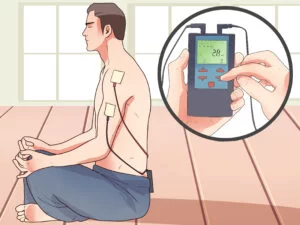
The side effects of electrotherapy are generally mild.
The most common side effect is patients complaining of skin irritation because of the adhesive on the electrodes. Sometimes burning sensation on the surface of the skin because of not using the device properly.
TENS (Transcutaneous Electrical Nerve Stimulation)
One of the most common electrotherapy devices use for pain relief. Small and sticky pads with electrodes are placed over or near the area where you sense pain. Your physiotherapist will decide the area of placement for electrodes. A series of low-voltage electrical currents send by the battery-operated unit to the area. You will increase or decrease the electrical current as well as the frequency and patterns of stimulation by the controller.
IFT (Interferential therapy):
IFT is a pain-relieving modality without side effects.
Effects of Interferential Therapy:
Increases blood circulation.
Reduces pain and inflammation.
Cures edema and hematoma.
Removes waste substances from the affected area.
Decreases blood pressure.
Treats chronic ligamentous lesions.
Causes vasodilation.
Increases metabolic rate.
Improves restricted movements of joints.
Increases muscle stimulation.
Restores the lost movement of muscles.
Conditions and Symptoms treated by IFT:
Disc herniation
Spinal canal stenosis
causalgia, herpes zoster, and neuralgia in these conditions Pain relief by IFT
Cervical spondylosis
Muscle injuries
Ligamentous injuries
Osteoarthritis
Ankylosing spondylitis
Rheumatoid arthritis
Frozen shoulder
Reduction of Edema
Contraindications:
Infective condition
Malignancy
Pacemakers
Loss of sensation
Danger of Hemorrhage
Large open wounds
Dermatological Conditions
Pregnant Uterus
Arterial disease
Febrile condition
Deep vein thrombosis
During menstruation
Unreliable patient
Fever
It depends on your radicular symptoms.
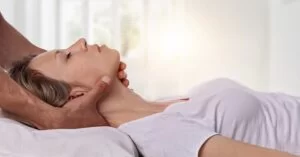
Ultrasound therapy:- It is effective in neck pain patients who have trigger points over the trapezius muscle or are associated with myofascial pain syndrome. Ultrasound therapy inactivates the trigger points and decreases the tension of soft tissues.
Cervical traction:
Cervical traction help to relieve pain. It involves using weights to increase space between the cervical joints and also relieve the pressure on the cervical discs and nerve roots.
Exercises for neck and shoulder:
With specific exercises and stretches, your symptoms may relieved.
Physiotherapist focuses on stretching and strengthening your muscles and also correct your posture.
Your physiotherapist will advise how long and how often you should practice these exercises, based on your symptoms and condition.
Stretching:
Below, we’ve got a treatment plan for moves to help stretch and strengthen the muscles in your:
neck
shoulders
upper back
For good results, try incorporating these stretches and exercises 3-4 times per week.
How to warm up
First of all, you’ve got to loosen up the muscles in your problem area with a dynamic warmup that includes mobility exercises.
Before you begin your workout, you would like to prepare your soft tissues (muscles, ligaments, and joints) for the work ahead. Therefore, adding a few dynamic stretching can help you warm up. You will also benefit from a 7–10 minute cardio warmup (such as walking, cycling, or a mild jog).
While static stretches — where you hold a stretch in one position for a few times that help to restore and maintain flexibility and promote the range of motion, they ought to mostly be left until after your workout or included within a more dynamic warmup routine beforehand.
This is because prolonged static stretching (especially 50-60 seconds or more) may temporarily reduce your muscular strength and endurance, response time, and overall performance.
If you want to add some static stretching to your warmup, attempt to limit the stretches to 10–20 seconds. Otherwise, leave it till your workout is completed.
Dynamic stretches [the neck, shoulders, and upper back]
Select a couple of the following exercises and perform them before your workout for 30 seconds to 1 minute each.
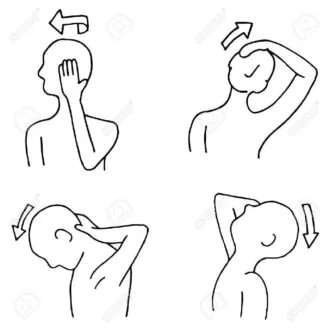
- Turn your neck
Slowly turn your neck towards one side and hold this position for 5-7 seconds.
Ensure that your jaw is at the same height throughout the stretching.
Gently turn your neck to the other side and hold this position for 5-7 seconds.
Repeat the exercise 3 times. - Neck tilt
It is the simplest exercise to relieve neck pain. Tilt your neck towards the floor and touch your chin to the chest.
Hold this position for at least 5-10 seconds. Return to the normal position.
Repeat the exercise 5-10 times according to your comfort. - Side tilt
Tilt your neck towards your shoulders and hold the position for 3-5 seconds.
Return your head to normal.
Tilt your neck to the other side and hold this position for 3-5 seconds.
Repeat the exercise at least 5-10 times on each side. - Shoulder extension
Straight your body and make sure your posture is perfect.
Push your neck forward and draw your shoulders together in alignment.
Hold the position for 5-7 seconds and feel the stretch on your neck muscles.
Gently return to your normal position.
Repeat the exercise 5-10 times according to your comfort. - Neck roll
Good for: neck and upper back
Stand or sit facing forward
Begin by tilting your neck to the proper
You should feel the stretch through your neck to your trap muscle
After a second, slowly roll your head counterclockwise
Pause for a second or two once you reach your left shoulder
Complete the rotation by ending in the normal position
Repeat these steps, rolling clockwise
Repeat this sequence 2–3 times. - Shoulder roll
Suitable for: shoulders and upper back
Stand with your arms facing the floor at your sides.
Roll your shoulders backward in a circular motion, completing 4-5 rotations.
Then complete 4-5 rotations forward.
Repeat this sequence 4-5 times.
Exercises for neck and shoulder
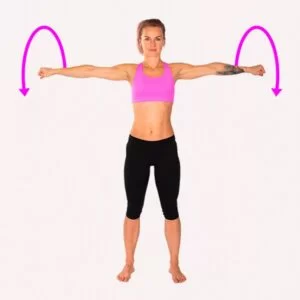
Arm circles
Good for: shoulders
Stand with your arms out to your sides (90-degree abduct your arms), parallel with the floor, with your hands facing down.
Slowly making small circles forward at first and eventually larger ones. Do this 15-20 times.
Reverse the movement and do another 15-20 circles.
Overhead arm reach
Suitable for: shoulders and upper back
Sit in a chair and face forward.
Extend your right shoulder above your head and reach to the left side.
Bend your torso until you feel the stretch in your right latissimus dorsi muscle and shoulder.
Return to the normal position. Repeat 4-5 times, then do the same stretch with your left arm.
Chair rotation
Good for: upper, mid, and lower back
Sit sideways in a chair and your right side should be resting against the back of the chair.
Keeping your legs immobile, rotate your torso to the right, reaching for the back of the chair with your hands.
Hold your upper body in rotation, using your arms to stretch deeper as your muscles loosen.
Hold for 10-15 seconds. Repeat 3-5 times on each side.
Exaggerated nod
The exaggerated nod counterbalances the downward and towards head position by pulling your shoulders down and back and increasing neck mobility.
How to do it:
Sit at your desk or relax your shoulder while standing. With your mouth closed and make sure your teeth touching but not clenching and look up to the ceiling.
Stop here and open your mouth and relax your jaw. Now see if you can bring your head further back up to an inch or two.
Keep your head fixed there and bring your lower part of the jaw to your upper part of the jaw, closing your mouth. You should feel a stretch in the front area of your neck.
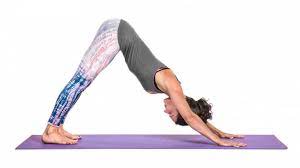
Downward-Facing Dog
Downward-Facing Dog is useful for opening the front chest wall and shoulders. which are often rounded and stiffened from overuse tech usage. This is all about upper-body strength, which means if you do not have shoulder strength you might compensate by bringing your shoulders up to your ears. If you notice yourself doing this, actively put your shoulder blades down your back side, which will create space in your neck.
How to do it:
Begin on all fours. Push your toes and lift your hips, reaching your hip bones toward the ceiling.
Reach your heels back toward the mat, but do not let them put on the ground.
Drop your head down so that your neck will become long. As you stay here, make sure that your wrist should stay parallel to the front side of the mat.
To reduce the pressure on your wrists, press on the knuckles of your forefinger and thumbs.
take at least 3 deep breaths and then release.
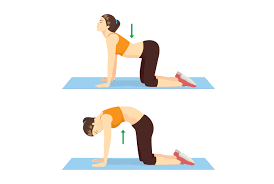
Cat-Cow
Your core and pelvis should drive the Cat-Cow flow As you inhale you create an anterior tilt to the pelvis so that your tailbone should face the ceiling, and while you exhale you create a posterior tilt so that your tailbone is facing the ground. This movement also helps increase spinal awareness, which is very important for perfect posture.
How to do it:
Start on all fours with your shoulders should be over your wrists, your hips store over your knees, and the top part of your feet pressed into the ground lengthen your head down to your tailbone to see a few inches in front of your fingers.
To begin the ‘cat’ phase, as you exhale use your abs to curl your spine towards the sky while tucking in your tailbone.
Allow your neck and allow your chin to reach down and in, toward your chest, so you can see your ears come down by your biceps.
To begin the ‘cow’ phase, as you inhale swoop and scoop your pelvis so your belly drops down to the floor.
Widen across your shoulder blades, keep your shoulders away from your ears, and lift your chin and chest to look up towards the sky.
Cycle through Cat-Cow sometimes, keeping stress and pressure out of the head and neck.
Knee to chest
Good for: lower back
Lie faceup on the floor.
Bend your one leg and bring it to your chest. Hold for 5-10 seconds, then release.
Repeat with your other leg.
Complete this sequence 3 time
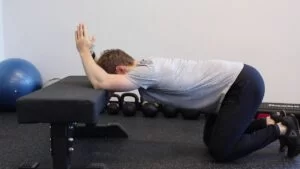
Thoracic extension
Good for: upper and mid back
For good results, you’ll need a foam roller or a chair.
If you’re using a foam roller, position it under your mid back (thoracic spine).
Allow your head and buttocks to fall on either side.
Extend your arms above your head to promote the stretch.
If you’re using a chair, sit facing forward and allow your upper body to fall over the rear of the chair.
Extend your arms above your head for promoting the stretch.
Hold either position for 5 seconds, then release. Repeat 3 times.
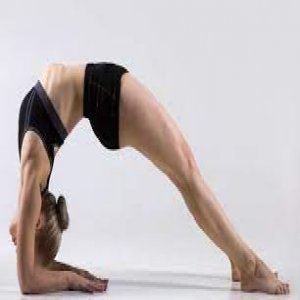
Bow pose
It helps to counteract slouched shoulders by stretch the pectoral muscles and strengthening upper back muscles.
How to do it?
Lie flat on your abdomen with your chin on the ground and your hand resting on either side of you.
Bend your knees and bring your heels as close to your gluteus as you can. Reach backward with both palms and grasp hold of your outer ankles.
As you inhale, raise your heels up toward the sky so that your chest, thighs, and upper torso elevate off the floor.
To intensify the stretch, try to elevate your heels higher while keeping your tailbone pressed into the floor.
Look forward and move your shoulders away from your ears.
Hold this position for 10 breaths.
Release an exhale by slowly letting down your thighs, and then relaxing your body, to the ground.
Chin tuck
It is a simple exercise you can do at your work, at your home. This simple stretch will help aware of the spine while strengthening the neck muscles to help pull your head back into alignment, says Cappo.
How to do it:
Sit up straight in a chair and keep your chin parallel to the ground. Without leaning your head in any direction, gently draw out your head and chin back, like you’re making a double chin. Be careful not to stick your head back. You should feel a stretch throughout the back of the neck.
Assume there’s a string pulling your head toward a higher level like a puppet, and actively elongate your neck.
Actively push the base of your head away from the base of your neck.
Keep your jawbone relaxed and hold this position for 3 deep breaths.
Release your chin forward. Repeat 10 times.
Strengthening exercises:
Strengthening the muscles in your neck, shoulder, and back is remarkable to reduce and prevent pain.
Many of these movements involve dumbbells or resistance bands, and few use just your body weight.
Pick a mixture of both types, if possible.
1. Row
Suitable for: upper back
Use a resistance band or a lightweight to medium dumbbell to finish this move.
Attach the resistance band to a pole or another stable surface and grab each handle, extending your arms.
Pull the handles straight back by bending your elbows, keeping them near to your body.
You should feel your lats (Latissimus dorsi) working.
If you’re using a dumbbell, hold it in your right hand and prepare yourself on a wall with your left hand, arm extended.
Hinge at the waist to a 45-degree angle, allowing the dumbbell to carry down.
Keep your neck neutral and your knees soft, pull the dumbbell perpendicular with a tucked elbow.
Perform 3 sets of 10–12 reps.
2. Face pull
Suitable for: shoulders and upper back
Use a resistance band to finish that move.
Attach the resistance band to a stable surface above eye level. Grab each handle with a grip.
Pull right toward your face, flaring your upper arms out to the sides and squeezing your shoulders together.
Pause, then return to the normal position.
Complete 3 sets of 12 reps.
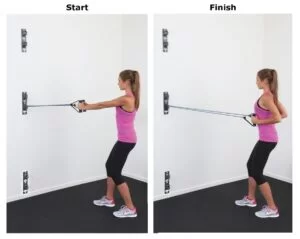
3. Scapular squeeze
Suitable for: shoulders and upper back
While standing with your arms down by your sides, squeeze your shoulder blades together.
Hold for 5-10 seconds, then release.
Repeat 3–5 times.
4. Wall angel
Suitable for: neck, shoulders, and upper back
Stand along with your back flat against a wall.
You’ll need to step your feet out slightly to allow your back to be completely against the wall.
Extend your arms bent to create a “T” shape against the wall, then bend your elbows to form 90-degree angles.
Slowly move your arms up and down during a “snow angel” movement, ensuring that they stay flat against the wall the full time.
When your fingers touch above your head, return to the normal position.
Complete 3 sets of 10-15 reps.
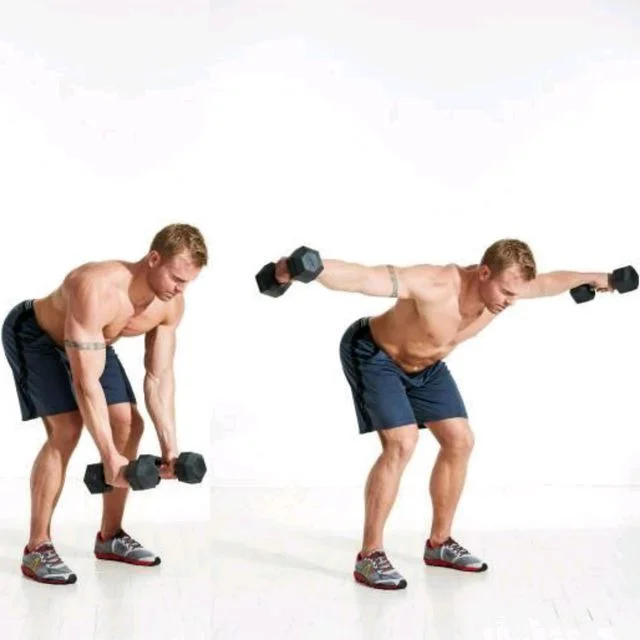
5. Reverse dumbbell fly
Suitable for: shoulders and upper back
Grab 2 light dumbbells and stand, hinged at the waist at a 45-degree angle, along with your arms hanging straight down.
Keeping your neck neutral and your gaze down, begin to lift your arms and bend the sides and up.
Squeeze your shoulders together at the end of the movement.
Complete 3 sets of 10–12 reps.
6. Lat pulldown
Suitable for: shoulders and upper back
Sit underneath a resistance band attached to a stable surface overhead.
Pull down on the band until your arms are parallel to the ground.
Pause at the underside, squeezing your lats, then return to the starting position.
Complete 3 sets of 10–12 reps.
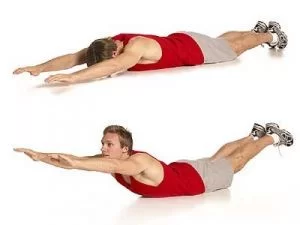
7. Superman
Good for: mid and lower back
Lie on your stomach along with your arms extended above your head.
Keep your neck neutral, and lift your arms and legs off the ground at the same time.
Ensure you’re using your back and glutes to lift.
Pause briefly at the top, then return to the normal position.
Complete 3 sets of 10-12 reps of the superman exercise.
Static stretches for after your workout
Try to include a few static stretching once your workout is complete.
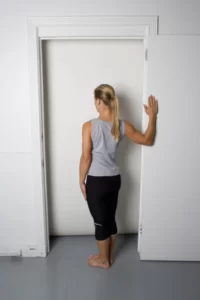
Pec stretch
Good for: chests and shoulders
You’ll need a doorway for this stretch.
Step into the corridor and place your forearms on the doorframe.
Make sure your elbows are flexed at a 90-degree angle.
Let your body weight fall forward slightly so that you feel a stretch in your chest and shoulders.
Hold for 10-15 seconds, then release.
Repeat 3-5 times.

Child’s Pose
Good for: shoulders, and back
Start on the ground on all fours.
With your big toes touching, spread your knees as far apart as they’ll go and sit your buttocks back onto your feet.
Sit straight up along with your arms extended above your head.
On your next exhale, hinge at the waist and let go of your upper body forward between your legs.
Allow your forehead to touch the ground, your shoulders to spread, and your buttocks to sink back.
Hold a minimum of 15-20 seconds.
Butterfly
Suitable for: shoulders and upper back
Put your hands on opposite shoulders and convey your elbows together to touch.
Hold for 10–20 seconds, then release.
Repeat 5 more times.
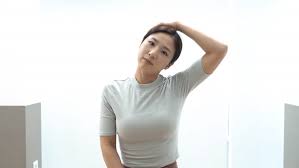
Upper trapezius stretch
Suitable for: upper back and neck
While sitting in a chair, take your right hand and place it on the back of your head.
Take your left hand and push it behind your back.
Using your right hand, slowly pull your head toward your right shoulder.
Hold this for 10–15 seconds.
Repeat on the other side.
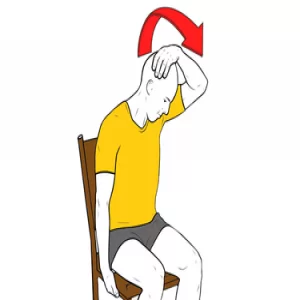
Levator scapulae stretch
Suitable for: neck and upper back
While sitting in a chair, turn your neck 45 degrees to the left.
Bend your neck downward (assume you’re looking into a shirt pocket).
You can use your left hand for a good stretch.
Hold this for 10–15 seconds.
Repeat on the other side
The bottom line
Neck pain with shoulder pain can be frustrating and debilitating.
Do remember that if your neck pain with shoulder pain does not go away even after a month, it is important to consult a physiotherapist to get to the root of the problem. In a few cases, neck pain with shoulder pain can be treated at home with daily stretching and strength training. On average, your neck pain should get better within 15-30 days. It is also important to change your lifestyle for preventing neck pain with shoulder pain, including proper postures and keeping your phone at an eye level to prevent further neck pain with shoulder pain.
Cervical epidural steroid injections for a pinched nerve in the shoulder
A cervical epidural steroid injection is an injection of anti-inflammatory medicine (a steroid or corticosteroid) into the epidural space around your spinal nerves in your neck region. The main goal of cervical epidural steroid injections for a pinched nerve in the shoulder is to help manage pain caused by irritation and inflammation of the spinal nerve roots in your cervical spine.
Surgery for a pinched nerve in the shoulder
Your doctor may recommend surgery if you’re experiencing severe and persistent pain despite trying nonsurgical therapy for at least 6 to 12 weeks or if you’re experiencing severe or worsening neurological issues due to a pinched nerve in the shoulder.
Several different surgical procedures can treat a pinched nerve in the shoulder. The procedure your doctor recommends will depend on many factors, including what symptoms you have, your overall health, and the affected nerve root.
The surgical approach will depend on a person’s signs and symptoms and what area of the tissue is pressing on the nerves.
To relieve pinched nerve in the shoulder at home
Your doctor or physical therapist can recommend you can take it at home to relieve a pinched nerve in the shoulder. These may include:
Using heat or ice packs twice a day for 10 min.
Doing gentle stretches or exercises which mention above.
Take medicines to relieve pain and inflammation such as ibuprofen.
Resting.
Temporarily stopping vigorous physical activity.
Sleep with a pillow designed to support the neck and shoulder.
Long-term strategies to reduce neck pain include:
Quit smoking. Smoking slows healing.
Lose weight if you are overweight.
Reduce your stress level. Walk, meditate, get a massage, and exercise.
Do exercises that strengthen your neck and shoulder muscles and also self-stretch neck muscles.
Is a pinched nerve in the shoulder curable?
While non-surgical treatment options usually successfully treat the symptoms of a pinched nerve in the shoulder, there isn’t a cure for the degenerative changes in your cervical spine that can cause a pinched nerve in the shoulder.
Prevention
How can I prevent a pinched nerve in the shoulder?
While you can’t always prevent a pinched nerve in the shoulder, there are certain things you can do to reduce your risk, including:
Maintaining a healthy weight
Staying physically fit
Practicing good posture
Doing stretching exercises to keep your muscles flexible
Specific risk factors for developing a pinched nerve in the shoulder include:
Manual labor involves heavy lifting or operating vibrating equipment.
History of chronic smoking.
If any of these risk factors apply to you, it’s important to talk to your doctor about specific things you can do to try to prevent a pinched nerve in the neck.
Prognosis
What is the prognosis for a pinched nerve in the shoulder?
The prognosis for a pinched nerve in the shoulder depends on several factors, including:
- Which spinal nerve is affected.
- The cause of a pinched nerve in the shoulder.
- How severe your symptoms are?
- Your overall health.
- In most cases, people who go through nonsurgical treatment have a good prognosis, and their symptoms also disappear. In fact, many people who have a pinched nerve in the shoulder can treat it at home with time and rest.
- However, symptoms of a pinched nerve in the shoulder recur (come back) in up to one-third of people after initial improvement.
- If your symptoms come back, it’s important to talk to your doctor.
When should I see my doctor about a pinched nerve in the shoulder?
If you have symptoms of a pinched nerve in the shoulder, such as pain that radiates down your neck, and that doesn’t go away after a week or more of rest, contact your doctor.
If you have more serious symptoms, such as muscle weakness or weakened reflexes in your arm, contact your doctor as soon as possible.
If you’re experiencing neck pain after an accident, such as a fall, contact your doctor or go to the nearest hospital.
A note from Mobile Physiotherapy Clinic
Having a pinched nerve in the shoulder can be uncomfortable and annoying. Most cases of this condition go away or symptoms disappear with rest over time. If your symptoms continue for more than a week, talk to your doctor. Several nonsurgical therapies can treat a pinched nerve in the shoulder.
FAQs
How do you treat a pinched nerve in your shoulder?
The most common course of treatment for a pinched nerve in the shoulder is a combination of conservative methods aimed at alleviating pain, lessening inflammation, and increasing range of motion. Physical therapy to strengthen muscles and improve range of motion, rest to enable the nerve to heal, and the use of nonsteroidal anti-inflammatory medicines (NSAIDs) or other painkillers are common therapies.
What does a pinched nerve in the shoulder feel like?
Typically, a pinched shoulder nerve will result in pain, numbness, or discomfort in the shoulder area. Other symptoms that a person may experience include changes in sensation on the side of the shoulder that hurts. muscular wasting in the shoulder, hand, or arm.
How long does a pinched nerve last in the shoulder?
Depending on how you treat it, pinched nerves may persist anywhere from a few days to approximately a month.
Can pinched nerve be cured?
Your doctor will advise you to avoid any activities that result in or exacerbate the compression, and depending on where the pinched nerve is located, you may need a splint, collar, or brace to immobilize the area. The most common therapy for a pinched nerve is rest for the affected area.
Is a pinched shoulder nerve serious?
The severity of a pinched nerve in the shoulder can vary, and whether it is serious will depend on the underlying cause, the degree of nerve compression, and how it affects your day-to-day activities. A pinched nerve is not normally thought to be a life-threatening disease, but if left untreated or if it persists, it can cause substantial pain and damage.

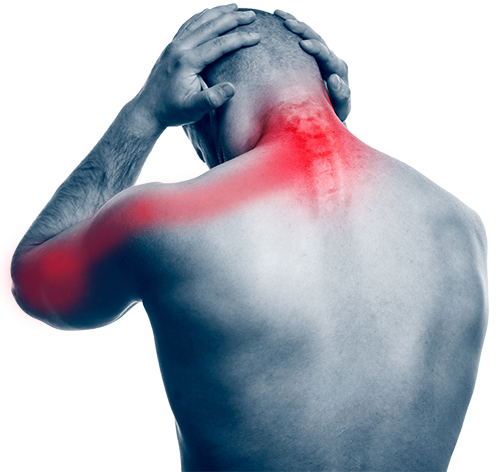
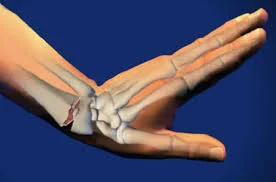

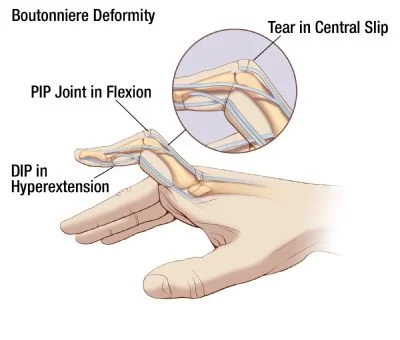


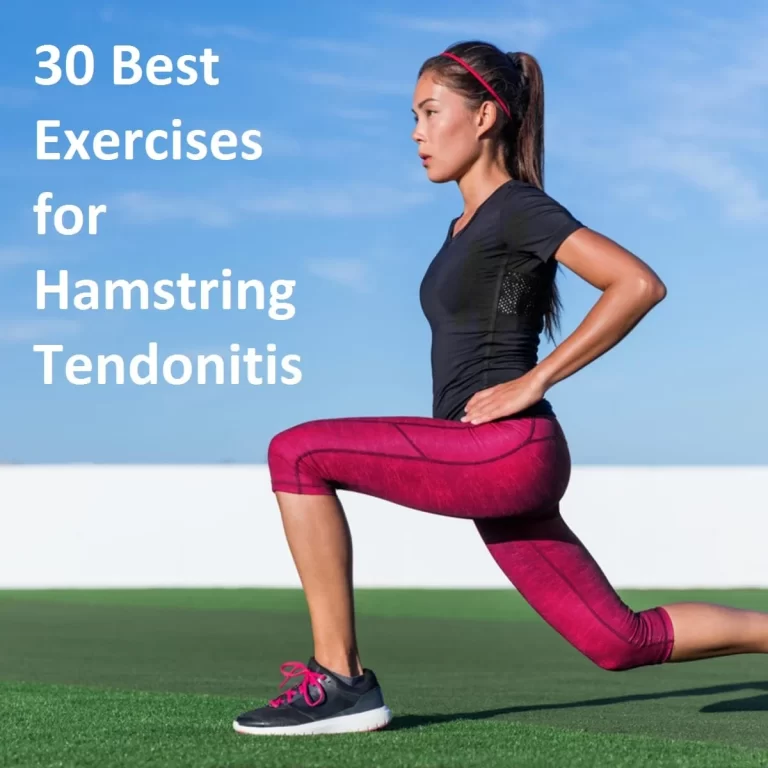
2 Comments